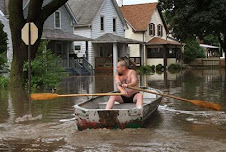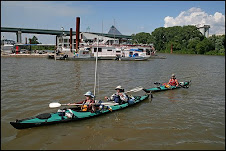How the expedition came to be:
The idea for this trip was originally Sarah's. Shortly after we came back from a 5 day kayak trip on the South island of New Zealand, Sarah suggested that we one day paddle down the Mississippi River. Sarah’s enthusiasm for the trip has since been tempered by the realization that the Mississippi will require a great deal of toiling under the sun and battling mosquitoes, but I have remained enamored with the idea ever since she proposed it. We put the river on the backburner for a few years, but this year, thanks in part to Fund for Teachers, things worked out for the trip to come together.
When I came across the Fund for Teachers Summer Fellowship Program I began to think about the river once again. Fund for Teachers is an organization that supports teachers in a variety of ways. One of their most innovative programs is the Summer Fellows program which awards grants that allow individual teachers and small teams of teachers to design fellowship experiences tailor made to improve their own teaching practice. This year alone Fund for Teachers in partnership with the Chicago Foundation for Education funded 31 proposals that will enable 49 Chicago Public School teachers to travel to 22 countries and 6 continents as they pursue their lifelong professional dreams. This year’s fellows will pursue activities as diverse as studying penguins off the coast of South Africa, attending a puppetry workshop in Italy and documenting folk festivals in Peru. Click the link on the top right of the page if you would like to learn more about Fund for Teachers.
My fellowship will allow me to conduct scientific research on nutrient pollution and microhabitats in the Lower Mississippi River as I paddle a sea kayak more than 1,000 miles from St. Louis to New Orleans. During the trip Sarah, Pat and I will be traveling in Feathercraft folding kayaks and camping nearly every night on sandbars, islands and the banks as we make our way down river collecting chemical and habitat data. Using this field experience I will develop a river ecology unit for my biology students.
What we hope to learn:
The chemical data that we will be collecting will help us to learn more about nutrient pollution in the Mississippi River watershed. As Nitrogen and Phosphorus from agricultural, municipal, industrial, domestic and natural sources make their way into the river they are carried south where they build up in the Gulf of Mexico. When these nutrients are present in high concentrations they lead to an explosion of growth among phytoplankton and green algae. This growth of autotrophs leads to an increase of zooplankton. As the plankton and algae start to die, there is an increased load of detritus or dead organic material which builds up on the bottom of the gulf. This detritus leads to an explosion in bacteria. These bacteria then use up nearly all available oxygen in the depths and create low oxygen or hypoxic conditions. If these hypoxic conditions are widespread and severe it leads to the formation of a dead zone, a large area nearly devoid of invertebrates and fish. During its summer peak the dead zone in the Gulf of Mexico, which is fueled by nutrient pollution in the Mississippi River, covers an area of roughly 8,500 square miles.
The Habitat data that we will be collecting is related to large woody debris, often called snags, in the river. Snags are important habitats for aquatic life in the river but are becoming increasingly rare in rivers as man-made alterations are made to river banks to allow for flood control, a faster flow velocity in the channel and easier navigation. We will be recording the frequency and locations of snags to see just how severely human manipulation of the river has affected these important microhabitats. Check out the links at the right to learn more about nutrient pollution, the dead zone and microhabitats.
2008/05/12
Subscribe to:
Comments (Atom)















